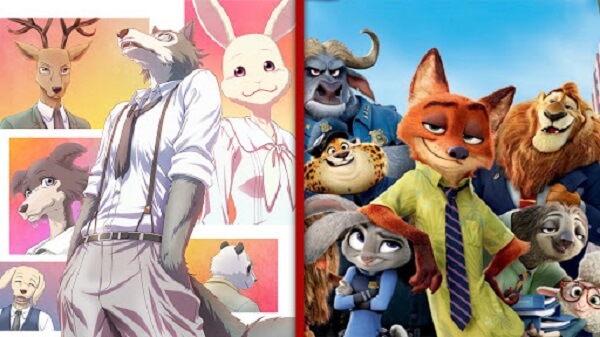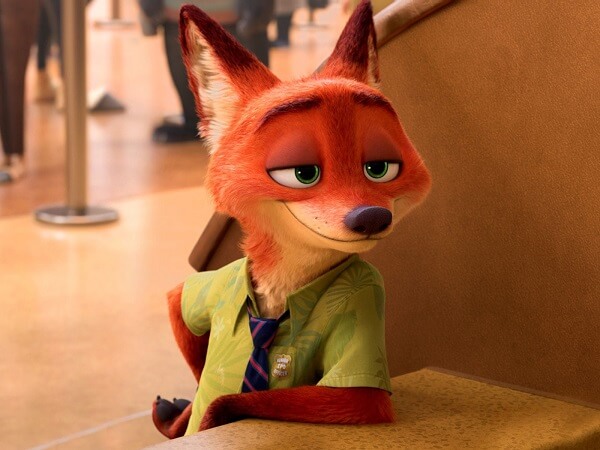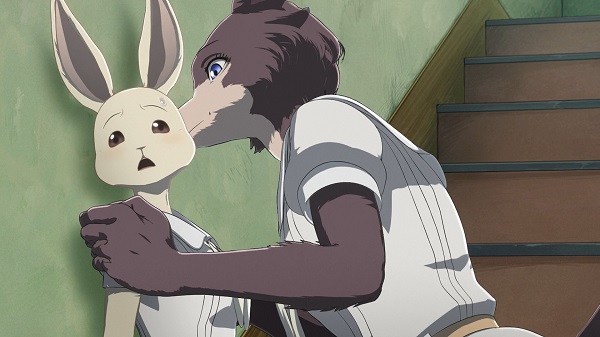As more people watch, like, and recommend BEASTARS, many have drawn comparisons to Disney’s Zootopia. It’s difficult to blame them for making this connection. BEASTARS and Zootopia are both stories about talking animals in society, and short comparisons are just easier to put together than long summaries or synopses.
Zootopia has remained popular in theaters since its initial release, so much so that even if most people haven’t seen it, they’ll likely know something about it. Critics of Zootopia have pointed to certain story elements as being shorthand for addressing real-life social issues, similar to Harry Potter.
Since BEASTARS’ debut, debates have erupted over which animated story about animals in society is better or deeper than the other. I’m not particularly interested in that debate. Instead, I’m more interested in the differences in how both of these stories use their animals in society, and how those differences result in BEASTARS and Zootopia being apples and oranges. They have similar settings but fundamentally different themes.
Allegory of Talking Animals
But, before we get into these two works, let’s talk about how animals are used in animated storytelling. What is it about talking animals that makes them so popular in cartoons? To begin with, young children enjoy animals. Western animation is still primarily aimed at families.
It’s no surprise that American cartoons, particularly Disney ones like The Lion King, have so many instances of talking animals in their features. Zootopia is not an exception to this trend in family-friendly media, with kid-targeted Japanese anime starring talking animals like Kimba the White Lion as well.
BEASTARS, on the other hand, is primarily aimed at teenagers and contains graphic violence and sexual imagery. Despite its kid-friendly rating, adults have praised Zootopia for including humor and themes that are still relevant to their generation. Zootopia includes jokes about sloths running the DMV as well as themes of prejudice against minorities.

BEASTARS and Zootopia both have themes that are difficult for the average grade schooler to grasp, themes that take advantage of the animal society setting to communicate a more complex message. That brings me to the next reason why animals talk: allegory.
Talking animals can be used as allegory by storytellers for their human audiences. The methods used by storytellers can be divided into two categories, with two poles on either end of the spectrum. One pole (let us call it the human pole) regards animals as effectively human beings who, aside from the skins they inhabit, think and behave in the same way that normal people do. The other (animal) pole views animals as essentially animals, from how they think to how they act, with the exception that they can communicate.
Speech is maintained as a constant in talking animal stories in order for the characters to be as relatable to audiences as possible. Aside from that, talking animals can be found in any part of this spectrum.
I’d put Zootopia closer to the human pole and BEASTARS closer to the animal pole on the human-animal spectrum. As a result, Zootopia leans more heavily on allegory than BEASTARS.
These placements determine where the themes of BEASTARS and Zootopia diverge. It is critical to consider how deeply talking animal stories lean into how allegorically comparable talking animals are to human audiences. One simple function of the talking animal allegory is that it can make certain messages more palatable to people who would otherwise react negatively or ignore them entirely.
Talking animals, like fantasy and sci-fi, provide morality-conscious storytellers with a way to provide creatively biting commentary on controversial issues, such as prejudice in general and racism in particular. The talking animal allegory can highlight and play with how single-mindedly bestial its characters are in comparison to their real-life human counterparts, which is a more complex function.
For millennia, philosophers have compared the status of humans to that of animals, with humans ranking higher and animals ranking lower due to their inability to exercise “civility”: a lack of free will, an inability to reason, and so on.
Zootopia, with its more animalistic cast, leans more heavily on the human comparison than BEASTARS, justifying their closer placements on the spectrum to the human and animal poles, respectively.
Comparable Situations: Predator and Prey
Now, let’s get more specific about BEASTARS and Zootopia, beginning with their settings. Please be aware that there will be spoilers for both BEASTARS and Zootopia. BEASTARS and Zootopia both use a common trope in talking animal stories: carnivore/predator and herbivore/prey living together, in addition to basing their narratives on talking animals in a society. Both stories have a long history of carnivores preying on herbivores. In both stories, carnivores are in the minority and herbivores are in the majority.
Zootopia tells the story of Judy, a diligent, aspiring bunny cop, and Nick, a sly huckster con-artist fox. Judy slams into a prejudicial reality of her larger animal colleagues, despite her dreams of becoming a respectable cop doing important police work to protect the community.
She is fired because of her small stature and assigned to the menial work of a meter maid. As a child hoping to be accepted as a respectable member of the boy scouts, Nick is stifled by the troop’s all-herbivore membership. He’s mocked for thinking he’ll ever be accepted by respectable people like them, leading him to believe that the only way he’ll ever make a decent living in this harsh reality is to become a dishonorable thief. Judy and Nick are both harmed by society’s judgment of them for who they are and dismissing their individual potentials and merits.
They both decide to work together to overcome these prejudicial impediments while solving an ongoing case of carnivores gone berserk, with Nick assisting Judy in being taken seriously as a cop and Judy suggesting to Nick that when everything is done, he can join the police force like her.
Their bond is nearly severed when Judy publicly expresses her own casual prejudices toward carnivores, claiming pseudo-scientifically that the case of carnivores going berserk may have something to do with their genetics, back when integrated animal society was not yet a thing and carnivores hunted herbivores for food by instinct.
Judy’s casual prejudice is suggested to be informed by a childhood experience of nearly being mauled by an ill-tempered carnivore neighbor, a neighbor who has since repented and will be reformed when she next meets him. She rushes back and apologizes to Nick for her bigoted remarks, which she combines with her discovery that plant toxins can turn any animal berserk if forcibly injected. They reunite once more to put an end to the crazed carnivore case, eventually locating the mastermind.
The villain is revealed to be an assistant mayor-turned-head-mayor who is a herbivore supremacist. She’s been gaining political power and marginalizing carnivores by combining her image as a harmless meek sheep, the agitation-inducing toxins, and Judy’s unfortunate statement.
BEASTARS is a story about many characters, the most prominent of which are Legosi, a kind-hearted but self-deprecating grey wolf, and Haru, a self-deprecating yet free-spirited dwarf rabbit. They have two kinds of first encounters that set the tone for the tension and conflict that will define their relationship for the rest of the series. In the first, Legosi almost devours Haru.
He falls in love with her in the second. Legosi, a normally gentle soul who takes great care not to inadvertently harm beetles, suffers from a condition shared by most carnivores: a powerful and sometimes overwhelming craving for meat that’s in his genes. Legosi is used to herbivores avoiding him as one of the animal kingdom’s alpha predators, so he is taken aback and becomes lovestruck when the rabbit he nearly ate cordially invites him into her company and hangs out with him, without pretension or aversion.
Haru, who is used to living with constant reminders of danger as one of the animal kingdom’s weakest herbivores, invites and encourages a relationship with her canine attacker, having already accepted that she will be eaten someday.

Legosi and Haru’s relationship is based on mutual respect for each other’s characters, which both question due to constant reminders of their antagonistic status as predator and prey. Even if it’s because of her death-resigned complex, Haru goes out of her way to make sure Legosi’s carnivorous status doesn’t affect how she interacts with him. Legosi falls for her and goes to great lengths to avoid appearing as a threatening predator as a result of her efforts to not judge him.
Their primal instincts as carnivores and herbivores complicate the feelings that arise from that respect. The sincerity of Legosi’s feelings is called into question throughout the series by suggestions that they are being confused with his genetic predatory desire to eat Haru. He attacked Haru in a predatory rage shortly after meeting her, and he has since stopped himself from claiming her as his prey. Haru’s sincerity is also tested, as she finds herself instinctively climbing into Legosi’s maw at one point. It’s framed as the primal desire of prey to be consumed, a desire that adds to her already low regard for the worth of her life.
Zootopia’s Civilized Human Pole
In Zootopia, talking animals dressed in animal skins are closer to humans. The film is closest to the human pole on the spectrum. Zootopia uses its talking animals to convey an allegorically universalist message: Zootopia is about prejudice, and prejudice is objectively unfounded and wrong-headed. The language used in Zootopia to compare majority-minority relations in countries such as the United States is a reference to the language used when comparing majority-minority relations in countries such as the United States.
There is widespread prejudice against racial and ethnic minority groups in the United States. These prejudices include the belief that African and Latino Americans are inherently more likely to commit violent crime than White Americans. The term “superpredator,” coined in the 1990s to describe the prediction of rising potential for violent crime committed by youths, has since become a dog whistle to demonize minority adolescents and young adults, and has served as the foundation for many “Tough on Crime” policies that would disproportionately impact minority communities for the worse.
In Zootopia, the association of minority-predator genetics with increased crime reflects a long and regrettable history of using pseudo-scientific discourse to justify prejudiced attitudes and public policy toward minorities. Two of the film’s most heinous criminals, the Godfather-style arctic shrew mob boss and the sheep prey-supremacist, are both herbivorous animals. Nick’s petty swindling activities appear tame in comparison, and the reasons he gives for turning to petty crime in the first place match a phenomenon sociologists call the “Self-fulfilling Prophecy.”
Because of his carnivorous origins, Nick was treated as a criminal-in-the-making by the herbivores who dominate his society from a young age. After being told that he will never be able to make a decent living no matter what he does, Nick concludes that he has little choice but to succumb to bigoted expectations and turn to crime in order to make a living at all. In place of prejudicial pseudo-scientific explanations, one alternative explanation for the relatively high rate of young minority members falling into crime compared to their majority White American counterparts has been the self-fulfilling prophecy.
BEASTARS’ talking animals are more similar to animals with human-like intelligence. The show is closest to the animal pole on the spectrum. BEASTARS uses its talking animals to communicate a more in-universe message based on this setup: BEASTARS features prejudice, and that prejudice is justified to some extent.
That prejudice stems from the fact that carnivores have a genetic craving for meat that they struggle to control and that sometimes overwhelms them. Predation attacks on herbivores continue despite the prevalence of alternatives to meat that more than meet the nutritional needs of carnivores and the government’s strict penalties for those caught in acts of predation.
There is an entire back alley economy dedicated to providing meat to carnivores of all stripes, and many of society’s more respectable carnivores live double lives, working alongside herbivores while secretly consuming black market herbivore meat. Many carnivores manage their urges better than others, but the real danger persists, lending some (if not complete) credibility to the prejudice they face from herbivores.

This genetically autonomous predator-prey dynamic that persists among carnivores is a scientifically established fact in the BEASTARS universe, a fact that bears no resemblance to any real-life human experience. Racial and ethnic minorities do not have an innate proclivity for violence and crime in the same way that carnivores have a preprogrammed urge to kill and eat herbivores.
The dissonance between worldbuilding and reality does not rule out all connections between BEASTARS’ talking animals and human audiences. It does, however, cast doubt on BEASTARS’ broad conclusions about real-life social issues like racism and majority-minority relations. BEASTARS’ cast, unlike Zootopia’s, are not animal stand-ins for humans dealing with allegorically human issues. They are talking animals who must deal with animal-specific issues.
Better Comparisons and Different Themes
BEASTARS and Zootopia appear to be similar on the surface. Their stories are based on talking animals in a society, as well as the hopes and tensions that arise from carnivores and herbivores living and working together as neighbors. They feature as well as comment on prejudice. They depict characters attempting to navigate a prejudiced society. However, whereas Zootopia focuses on how prejudice is objectively wrong in its universe, BEASTARS provides some justification for prejudice in its world.
Zootopia’s characters have evolved from their savage genetic roots as a result of their society’s civilization. Despite their society’s civilized trappings, BEASTARS characters retain their congenital bestial instincts. This distinction does not imply that one franchise is more compelling or problematic than the other. Neither animated work attempts to be an allegory in the same way.
Zootopia is a film that encourages one-on-one comparisons between its talking animal characters and real-life human experience in order to convey an unmistakably progressive moral. BEASTARS is a show about talking animal characters who struggle with genetic predispositions that have little parallel in real-life human experience.

BEASTARS shares more in common with anime like Sankarea and Kara no Kyoukai than with Zootopia, which does not feature any talking animals. Kara no Kyoukai is about a fighting girl, while Sankarea is about a zombie girl. The struggle with single-mindedly destructive, bestial impulses that they were born with is what these characters have in common with Beastar’s wolf boy.
Rea Sanka from Sankarea struggles against degrading into a mindless flesh-eating zombie, just as Legosi was born as a carnivore and struggles with his genetically predatory instincts, and Shiki Ryougi from Kara no Kyoukai struggles against giving in to her congenital predisposition as a killer. All three have love interests, and to varying degrees, they struggle with not mistaking them for fodder for their destructive perversions.
Also, Read Angel Adoree, Ava Michelle Cota, Kaitlin Sharkey, Melanie Olmstead
